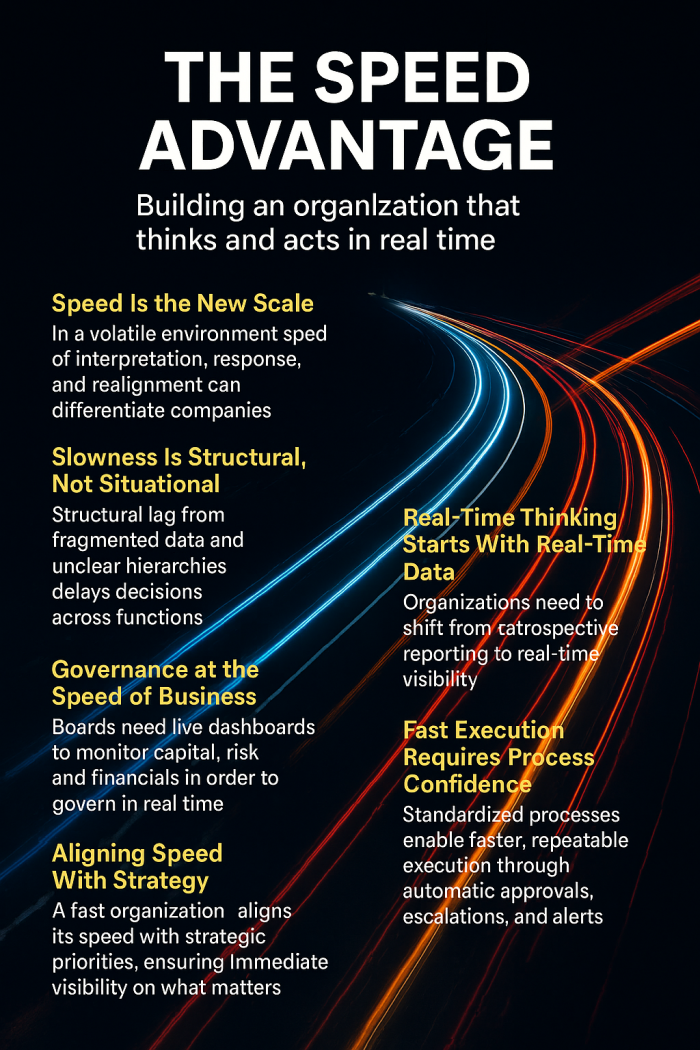Speed Is the New Scale
In traditional industrial thinking, scale was the barrier to entry and the engine of dominance. But in today’s volatile, information-rich world, speed has become the new strategic currency. Companies that can interpret events faster, respond sooner, and realign operations dynamically—not quarterly—are pulling ahead. Speed has shifted from being a luxury to being a decisive competitive edge..
Slowness Is Structural, Not Situational
Most slow decisions aren’t caused by indecisive managers—they’re caused by systemic lag. Data is fragmented across systems. Reporting cycles are monthly or ad hoc. Approval hierarchies are unclear. Teams wait for dashboards instead of acting on live indicators. In high-capex industries, this delay compounds across functions: delayed production decisions lead to procurement missteps, maintenance backlogs, and budget shocks. Slowness is built into the system—and that’s precisely where leadership must intervene.
Real-Time Thinking Starts With Real-Time Data
If your dashboard tells you what happened last week, your decisions are already outdated. Industrial organizations must shift from retrospective reporting to real-time visibility—where operations, asset conditions, financials, and risks are accessible on demand. This doesn’t mean flooding managers with more data—it means designing systems where the right information surfaces to the right person at the right time to take action. Real-time decision making is critical in fast-moving environments.
Governance at the Speed of Business
Speed isn’t just for operations—it’s also for the boardroom. Strategic decisions suffer when executives rely on spreadsheets consolidated days or weeks after the fact. Today’s boards need live dashboards for executives to manage capital deployment, risk exposure, and financial alignment. The question isn’t “What happened?” but “What’s changing now— and how do we respond?” Boards that govern in real time enable management to execute at pace.

Fast Execution Requires Process Confidence
Speed without structure leads to chaos. But when processes are standardized, digitized, and enforced, execution becomes faster—because it’s repeatable. Approvals, escalations, reorders, and alerts can happen automatically within defined tolerances. Field teams spend less time asking permission and more time solving problems. Fast organizations aren’t reckless—they’re structured for pace. Operational agility depends on process discipline.
Aligning Speed with Strategy
Fast doesn’t mean reactive. It means responsive—with intent. A fast organization doesn’t just react to what’s happening—it aligns speed to strategic priority. That means enabling immediate visibility on what matters: downtime risk, budget deviation, supply lead-time, or regulatory exposure. When everyone sees what matters most, they move in sync. Speed, in this case, becomes strategic coherence in motion. Digital transformation in heavy industries enables this shift.
The Cost of Delay Is Growing
The difference between companies that act in real time and those that wait to report it quarterly is growing starker. In your industry, hours lost mean revenue lost. Slow approvals mean lost opportunities. Lagging visibility means rising exposure. If your organization is not built for speed, it is built for stagnation. And in the next market shift, that may be the difference between leading and losing. That’s why data-driven leadership is now essential.
